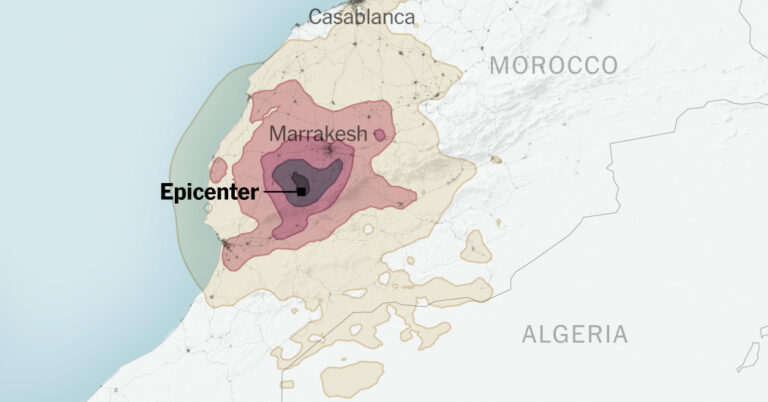An earthquake, which had a magnitude of at least 6.8, struck Morocco on Friday, devastating a region where many vulnerable buildings were unable to withstand the shaking. Official estimates of the death toll grew into the thousands on Sunday.
Rubble filled some alleyways in Marrakesh, one of Morocco’s largest cities, but the highest death tolls so far have been reported in the small communities of the High Atlas mountains. Mud brick buildings common to the region — some of which date back to before Morocco’s colonization by the French — were reduced to a collapsed sand castle.
Talat N’yaaqoub, Morocco
Sources: Maxar Technologies, Google Maps
Reports on social media said that some villages had yet to receive any assistance more than a day after the earthquake.
Shake intensity near the epicenter
Sources: U.S. Geological Survey (earthquake intensity reported as of Sept. 10 at 4 p.m. in Morocco); GHSL – Global Human Settlement Layer, European Space Agency.
The New York Times
Some roads appeared to be blocked by landslides and phone service had been knocked out in many places, making rescues harder.
Source: Maxar Technologies
As of Sunday, the largest number of victims accounted for so far are in the Al Haouz province, a mountainous region of small hillside towns south of Marrakesh, and Taroudant, south of the epicenter. Many of the areas affected by the quake are remote mountain villages that are not easily accessed by emergency teams.
Regions with highest death tolls
Sources: U.S. Geological Survey (epicenter); WorldPop (population data)
Note: Includes areas that have reported more than 10 deaths as of Sept. 10 at 6:00 p.m. in Morocco. The Greater Casablanca region, Tinghir, the Youssoufia province and the prefecture of Agadir Ida Outanane have also reported deaths.
The New York Times
The quake was the strongest to hit the area in more than a century. The U.S. Geological Survey called serious earthquakes in Morocco “uncommon but not unexpected.”
The most deadly earthquake in Morocco’s recent history struck near Agadir in 1960, killing at least 12,000 people. The coastal city is located 80 miles southwest of the epicenter of Friday’s quake.
Major earthquakes since 1900
Source: U.S. Geological Survey
Notes: Includes earthquakes since 1900 that have a magnitude of at least 4.5 according to the U.S. Geological Survey.



